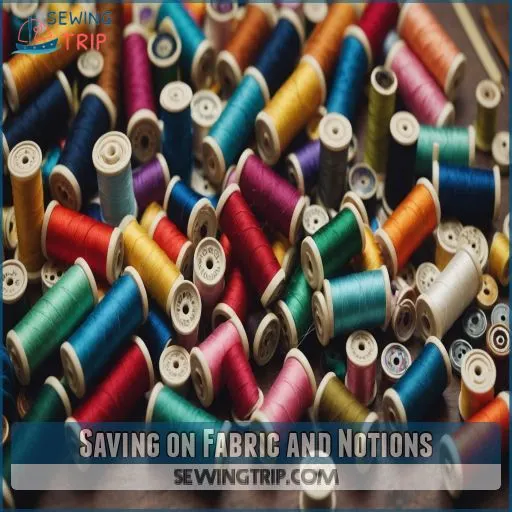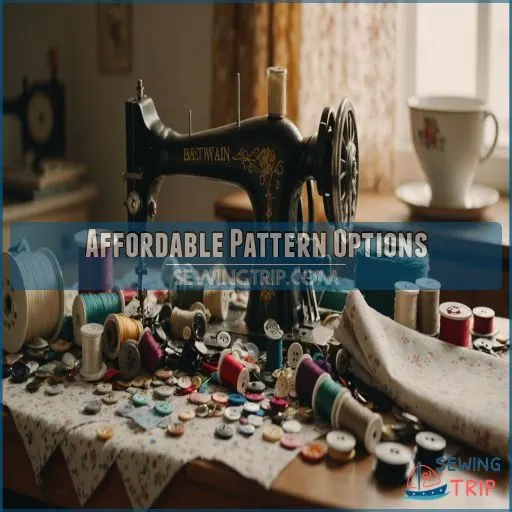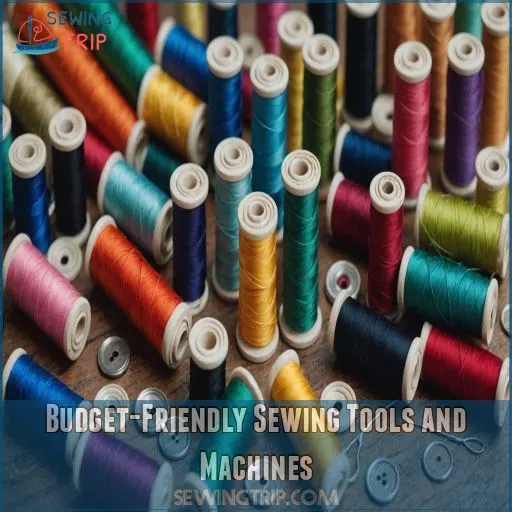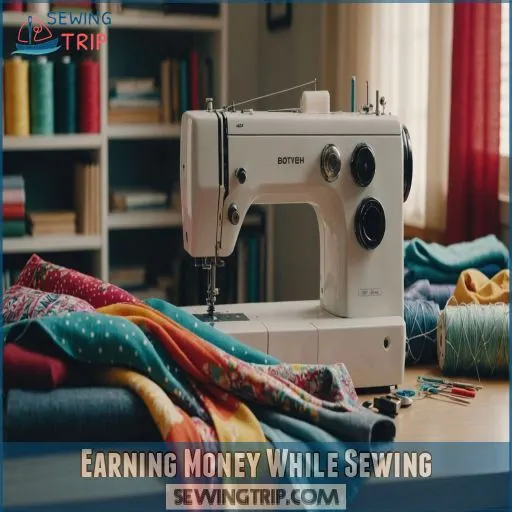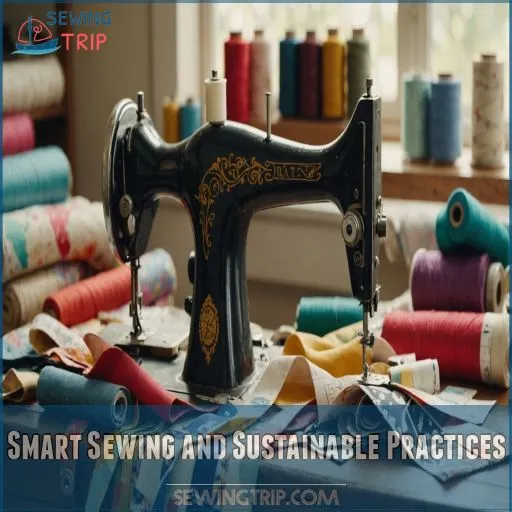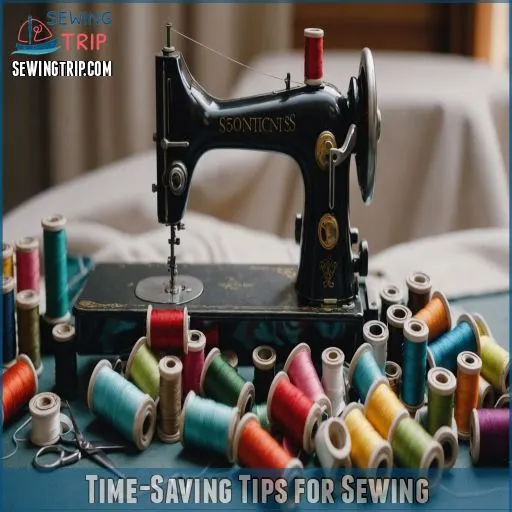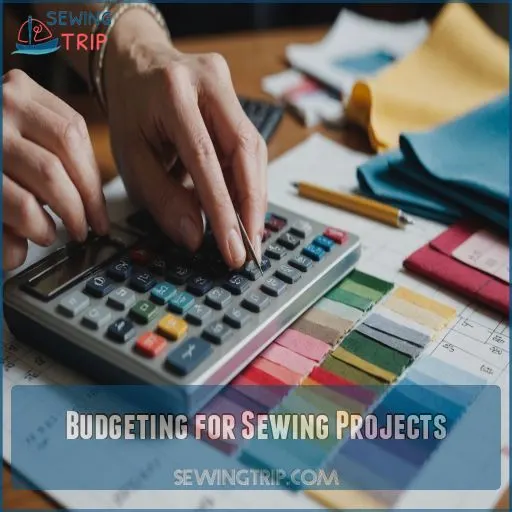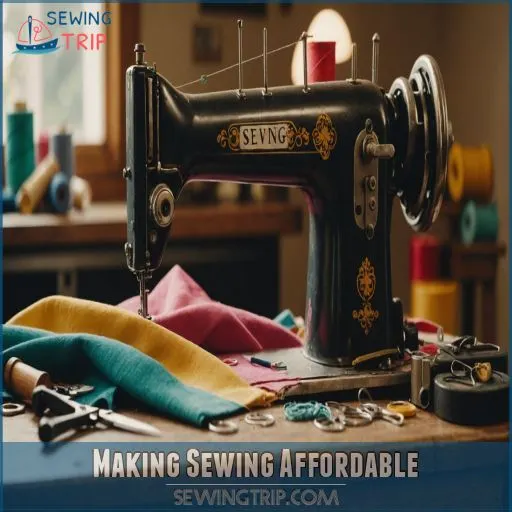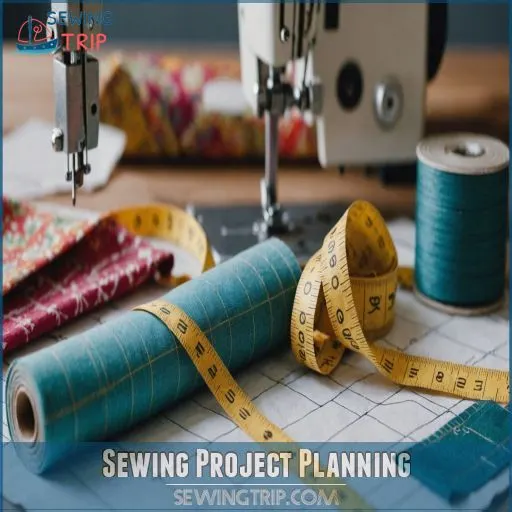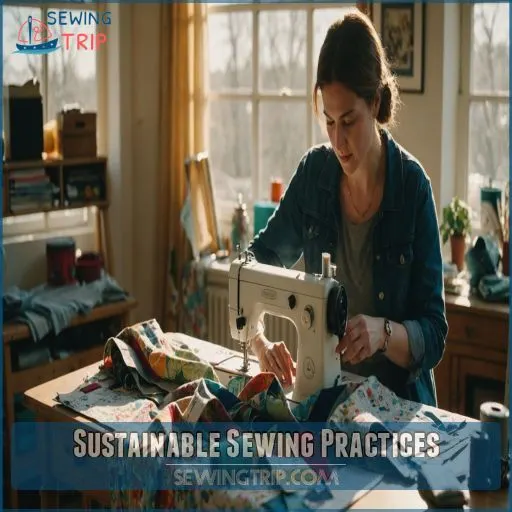This site is supported by our readers. We may earn a commission, at no cost to you, if you purchase through links.
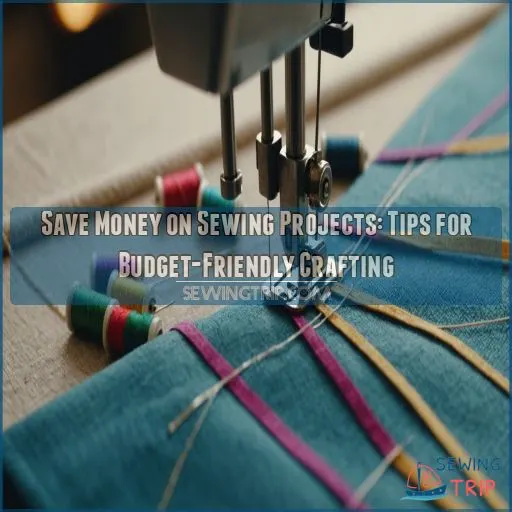
Embrace thrift stores for unique finds, or breathe new life into old clothes. Trade fabrics with friends and spice up your designs with free online patterns. Secondhand sewing machines can be your new best friend, and maintaining them will keep them running like a dream.
Jump into sustainable sewing by repurposing scraps and using affordable embellishments. And who doesn’t love a good sale? Keep your eyes peeled! Ready for more wallet-friendly tips? Sew on, savvy saver!
Table Of Contents
- Key Takeaways
- Saving on Fabric and Notions
- Affordable Pattern Options
- Budget-Friendly Sewing Tools and Machines
- Earning Money While Sewing
- Smart Sewing and Sustainable Practices
- Time-Saving Tips for Sewing
- Budgeting for Sewing Projects
- Making Sewing Affordable
- Sewing Project Planning
- Sustainable Sewing Practices
- Frequently Asked Questions (FAQs)
- Conclusion
Key Takeaways
- Scour your fabric stash and get creative with thrifted finds—it’s like a treasure hunt that’ll save you a bundle!
- Embrace free online patterns, library books, and pattern hacking to craft unique designs without breaking the bank.
- Snag secondhand sewing machines and tools, then keep them running like a dream through regular maintenance.
- Sew sustainably by repurposing scraps, using affordable embellishments, and taking advantage of sales—your wallet and the planet will thank you!
Saving on Fabric and Notions
Sewing doesn’t have to break the bank!
Discover clever ways to save on fabric and notions,
from tapping into your stash
to scoring deals at thrift stores
and swapping with sewing friends.
Use Your Stash Before Buying
Before you buy new fabric, take a look at what you already have – your fabric stash has hidden gems!
With a bit of stash organization, you could stumble upon forgotten treasures and finish those work-in-progress projects.
Have a stash challenge: create something from what you already own.
Who knew a fat quarter could be so transformative?
Buy Remnants and End Cuts
Before rushing out to buy new fabric, spin around your stash and focus on those leftovers!
Remnants and end cuts are hidden gems at fabric stores.
- Ask staff about the remnant section.
- Look for high-quality end cuts.
- Store remnants by size and type.
- Repurpose them perfectly in scrappy projects.
Happy sewing!
Thrift Stores for Affordable Fabrics
There’s gold in them thar thrift stores!
You’ll uncover a treasure trove of fabrics waiting to be transformed into fabulous sewing projects, using sewing tips and tricks to help you along the way.
Thrifting fabric can save you money, but you’ll enjoy the thrill of finding unique patterns.
Besides, discovering quality fabrics among hidden gems is like a scavenger hunt.
Take control, sew sustainably, and alter patterns creatively!
Repurpose Old Clothes and Household Items
Instead of discarding old clothes and household items, consider repurposing them for your sewing projects.
Transform worn-out garments into:
- Stylish accessories like tote bags, pouches, or scrunchies.
- Cozy quilts or throw pillows using fabric scraps.
- Unique home decor pieces like wall hangings or vases.
This creative approach can breathe new life into your sewing stash while saving money.
Swap Fabric Orders With Sewing Friends
Rather than reinventing the fabric wheel, join forces with sewing friends!
Fabric swaps bring excitement to projects by adding variety without spending a dime.
Group discounts and shared stashes are game-changers—like finding the pot of gold at the end of a rainbow.
Online communities foster camaraderie, creating a sense of belonging while creatively saving money on sewing adventures.
Affordable Pattern Options
Finding affordable patterns might seem tricky, but there are plenty of clever ways to save without sacrificing style.
Free patterns, altering what you already own, or raiding the library’s pattern books, you’ll have a fantastic wardrobe without breaking the bank.
Free Patterns Available Online
After saving on fabric, let’s chat about free patterns available online! They’re a lifesaver for every sewist. Many sites offer free gems you can snag without busting your budget.
- Consider pattern quality: Read reviews first.
- Watch for legal concerns: Make sure they’re actually free.
- Experiment with pattern variations: Mix it up to suit your style!
Alter Existing Patterns to Save Money
By altering existing patterns, you can save a bundle on sewing projects.
Get creative with pattern hacking – tweak the neckline, adjust the sleeves, or even combine multiple designs.
A little DIY pattern magic can transform basic styles into one-of-a-kind creations.
Give it a try and watch your sewing budget stretch further!
| Alteration Technique | Description | Difficulty Level |
|---|---|---|
| Neckline Adjustment | Modify the neckline shape or depth | Beginner |
| Sleeve Adjustment | Adjust the sleeve length or style | Intermediate |
| Pattern Combination | Blend elements from multiple patterns | Advanced |
Utilize Pattern Books From Libraries
After tweaking patterns, why not borrow library pattern books? It’s like a treasure chest of inspiration without spending a dime.
Join pattern book swaps for even more options! Libraries often have collections that cater to sewing ambitions for all budgets.
Just think of it as gathering sewing advice from seasoned pros, helping you save money on sewing projects.
Learn Pattern Alteration and Combination Techniques
Got a stack of pattern books from the library? Now’s the time to get creative!
Tackle sewing challenges by hacking those patterns.
Mix and match designs for unique creations—think of it as a sewing buffet.
Vintage patterns and fabric manipulation are your secret sauce.
With pattern hacking, you’ll sew for all desires, needs, and styles, crafting designs uniquely yours.
Take Advantage of Sales on Paper Patterns
Sewing projects get a boost when you snag Big 4 patterns during sales! Rather than hoarding patterns, relish the thrill of the hunt during sales for those $1 treasures. You’ll feel like a sewing superhero. Dance a jig down the aisle and indulge in guilty pleasures. With patterns discounted, you’ve got sewing for all seasons covered!
- Conquer pattern hoarding
- Outshine pattern sales
- Embrace pattern swapping
- Unlock dreams with creativity
Budget-Friendly Sewing Tools and Machines
Sewing doesn’t have to break the bank.
From scouring thrift stores for gently used tools to investing in high-quality essentials, there are plenty of budget-friendly ways to build up your sewing arsenal without sacrificing quality.
Buy Secondhand Sewing Machines
Looking for a sewing machine doesn’t have to cost an arm and a leg. Buying secondhand from reputable sellers can save you a bundle. But, it’s key to check the machine’s quality and maintenance history.
| Consideration | Details | Tip |
|---|---|---|
| Quality | Check for smooth operation | Test before buying |
| Maintenance History | Regular cleaning and oiling are important | Ask for service records |
| Cost Comparison | Compare with new options | Make sure it’s a good deal |
Thinking about starting a side business or sewing for adults? Make sure those gears tick!
Thrift Stores for Sewing Notions and Tools
Stumbled upon sewing machine deals or repurposed treasures at thrift stores lately? It’s like finding hidden gems that make budget-friendly sewing your new best friend!
Explore aisles filled with buttons, zippers, and cutting tools that won’t break the bank.
It’s sewing for everyone, opening up new possibilities and crafting futures with every thrifty find. Who knew saving could be this fun?
Invest in High-Quality Tools Used Frequently
You’ve snagged thrift store finds, now think "quality over quantity" for tools. A top-tier pair of scissors? That’s your Excalibur! You’ll find these essentials worthy companions in your sewing kingdom.
- Scissors: Sharp and reliable, they can cut through fabric and time!
- Pins: Secure your defense against hasty seams.
- Rulers: Guide your creativity with precision and flair.
Maintain Sewing Machines to Extend Their Life
By regularly maintaining your sewing machine, you can extend its lifespan and save money in the long run by following a sewing machine cleaning guide.
Regular maintenance includes cleaning the machine, oiling the moving parts, and replacing any worn-out components.
A well-cared-for machine will sew smoothly for years, allowing you to tackle projects with confidence and ease.
Explore Resale Fabric Stores for Discounted Materials
Speaking of maintaining your sewing machine, why not check out resale fabric stores for treasures? You never know what hidden gems you’ll find there:
- Magical steals: Uncover unique textiles at unbeatable prices.
- Eco-friendly adventures: Embrace repurposed materials.
- Inventory surprises: Snag unexpected delights.
- Wallet-friendly thrills: Stretch your sewing budget.
- Imagine the creativity: Spark with discounted materials.
Happy hunting!
Earning Money While Sewing
Turning your passion for sewing into a money-making venture is easier than you think!
Sell your handmade creations online, just remember to price them wisely by factoring in both your time and materials, and don’t forget to charm your customers with a touch of friendly marketing magic.
Sell Creations on Online Markets
Who says you can’t make money while sewing?
Platforms like Etsy, Shopify, Instagram, and Facebook Marketplace are the perfect spots to sell your creations and start your sewing business.
Share your projects on Pinterest for extra visibility.
Your grandma may not understand hashtags, but your unique pieces will surely attract customers who appreciate your craft.
Price Work Competitively Considering Time and Materials
When pricing your sewing work, consider the time and materials invested.
Determine an hourly rate that covers your costs and provides a fair profit margin.
Factor in the complexity of the project – more intricate pieces may warrant a higher price.
Be mindful of your client’s budget to find a mutually agreeable rate.
Utilize Effective Marketing Strategies and Customer Engagement
Social media is your sewing sidekick, helping build your brand with engaging posts.
Post your creations in online shops for visibility, and don’t forget the power of email lists to keep fans in the loop.
Encourage glowing customer reviews with a personal touch, and remember, you’re sewing for the why not, turning “no” into a penny-pinching "yes!
Cash Back Programs for Sewing Supplies
Let’s face it; every penny counts when you’re sewing on a budget.
Cashback apps are your secret weapon for scoring sweet sewing supply deals.
Sites like Rakuten or Honey reward you for buying essentials.
You’ll feel like a master of savings as you earn rewards on fabric and pillow forms, letting you stitch happily ever after!
Referral Bonuses for Sharing With Sewing Friends
Cashback programs can really stretch your budget.
Speaking of which, have you tried referral bonuses? Sharing your love for sewing with friends pays off! You’ll love:
- Discounts for friends: Share the stitching joy!
- Boosting sewing communities: Unite in creativity.
- Saving on supplies: Pool together and buy smart.
- Collaborative projects: Build dreams with thread.
Smart Sewing and Sustainable Practices
Sewing doesn’t have to break the bank.
With a little creativity and resourcefulness, you can embrace smart sewing practices that save money and reduce waste.
From repurposing old fabrics to exploring budget-friendly alternatives, this guide will show you how to craft stylish projects without sacrificing your budget.
Repurpose and Upcycle Old Fabrics and Garments
Breathe new life into fabric scraps and second-hand fashion.
It’s not just smart—it’s savvy!
Why toss what you can transform?
When you repurpose textiles and upcycle clothing, your wallet will thank you.
| Old Sweaters | Turn into cozy mittens |
|---|---|
| Jeans with wear & tear | Craft into a trendy bag |
| Worn t-shirts | Make vibrant pillow covers |
| Dress shirts | Sew into stylish aprons |
Get Creative With DIY Projects and Transformations
Ready to turn your scraps into treasures? Get into repurposed fashion or upcycle textiles into new creations!
That old pillowcase? A chic tote. The tattered jeans? Stylish patchwork. DIY home decor like fabric-covered storage boxes adds flair.
Infuse sustainable crafts into your routine, transforming would-be trash into treasures and saving both your wallet and the planet.
Use Expensive Materials Sparingly in Projects
Making a masterpiece? It can be tempting to splurge on luxury materials, but why not treat them like the dessert of your project?
Use costly fabrics like a cherry on top—sprinkle them sparingly.
It’s all about the grand illusion!
Get creative with off-cuts and trimmings, weaving a rich tapestry without unraveling your budget.
Your wallet will thank you!
Explore Budget-Friendly Fabric Alternatives
Don’t let a tight budget hold you back! Explore budget-friendly fabric alternatives like:
- Recycled materials: Scour thrift stores for vintage sheets, curtains, or clothing that can be repurposed.
- Natural fibers: Opt for linen, cotton, or wool – they’re often more affordable than synthetic options.
- Upcycled textiles: Get creative with old t-shirts, pillowcases, or even flour sacks to add unique character to your projects.
Choose Affordable Embellishment Options
Sprinkle your projects with pizzazz by opting for budget-friendly embellishments! Beads and buttons add flair without breaking the bank, while ribbons and lace weave elegance into any creation.
Got embroidery skills? Use leftover threads to jazz up plain fabrics.
Think of these littles as the sprinkles on your cupcake, making everything pop without the hefty price tag.
Time-Saving Tips for Sewing
You might not have the powers of a sewing wizard, but with some clever tricks, you’ll save time and money by using fabric scraps.
Start by organizing your stash of sewing supplies and keeping those patterns in check, so you don’t end up buying something you already have.
Plan Wardrobe Silhouettes Before Purchasing Patterns
Before diving into patterns, envision your perfect wardrobe silhouettes.
What inspires you?
Align patterns with your body shape and wardrobe goals.
Think of pattern hacking as your secret ingredient to creative freedom.
Analyze your style—are you adding flair or keeping it simple?
This pre-purchase detective work saves money and makes sure each piece fits like a glove.
Learn Fabric Usage Techniques to Minimize Waste
Mastering fabric usage techniques can help you minimize waste and maximize efficiency.
Start by learning how to cut patterns efficiently, minimizing leftover scraps.
Explore creative ways to repurpose fabric remnants, like using them as interfacing or turning them into small accessories.
With a bit of practice, you’ll become a pro at minimizing fabric waste.
Organize Sewing Supplies to Avoid Forgetting What You Have
Now that you’re optimizing fabric usage, organizing your sewing supplies can really stitch up time savings!
Imagine your sewing room layout with a labeled system; it’s like having a magic map for your stash.
By organizing fabric storage by type and keeping a stash inventory, you’ll avoid buying repeats and spend more time creating stunning projects!
Clean Up and Organize Your Sewing Stash
A well-organized sewing stash is your secret weapon against chaos.
Conduct a stash audit to take fabric inventory—trust me, it’s as satisfying as decluttering a junk drawer.
Use clever storage ideas and organization tools to design a sewing room layout that sparks joy.
Tidying up means you’ll actually find those amazing fabrics instead of just dreaming about them!
Utilize Tracing Paper to Preserve Original Patterns
Don’t let your patterns go the way of those mystery socks lost in the laundry!
Use tracing paper as an inexpensive alternative for pattern storage and preservation.
It’ll save your original patterns, ensuring pattern longevity.
Just place the tracing paper over your pattern, trace carefully, and voilà!
You’ve got a durable copy ready for countless future projects.
Budgeting for Sewing Projects
Sewing can be an expensive hobby, but with smart budgeting, you can stretch your dollars and make the most of your crafting projects.
From setting realistic budgets to taking advantage of sales and coupons, this guide will help you sew in style without breaking the bank.
Set Realistic Budgets for Fabric, Notions, and Tools
Within the whirlwind of sewing projects, set a realistic budget for fabric, notions, and tools.
Use budgeting like a seasoned captain; track every expense.
Avoid letting notions steal your shirt, and keep fabric buys as buttoned up as possible!
Prioritization will help you find value and cut costs, leaving more room for creative freedom.
Remember, every stitch counts!
Prioritize Essential Supplies Over Optional Ones
In the sewing world, it’s easy to buy every shiny thingamajig.
However, savvy sewing‘s all about focusing on essential tools and smart fabric choices.
Good project planning helps your stash management align with budget limits, saving you from spending your bobbin money.
Remember, it’s more fulfilling to stitch with purpose than to hoard a Mount Everest of unused notions!
Shop During Sales and Use Coupons
Fine-tune your crafting on a budget with a smart sales calendar approach. Here’s how to take advantage of those pesky retail tricks:
- Best coupon apps: Download apps for deals.
- Coupon stacking: Combine coupons for extra savings.
It’s like treasure hunting without a map!
- Keep a fabric stash management system.
- Plan ahead for sales to avoid impulse buys.
Consider Buying in Bulk to Reduce Per-Unit Cost
When sewing on a budget, consider buying supplies in bulk to score better deals.
Scour wholesale suppliers or fabric stores offering bulk pricing – you’ll often pay less per unit.
Just be mindful of storage space and make sure you’ll use the materials before they expire.
Bulk buying can stretch your sewing budget further when done strategically.
Regularly Assess Your Stash to Avoid Duplicate Purchases
Constantly evaluating your fabric inventory helps avoid buying duplicates, saving money, and preventing that frustrating “I’ve already got this!” moment.
Here’s how:
- Keep a detailed list of your fabric stash.
- Organize by color and type for easy access.
- Regularly update your sewing budget and project planning.
This way, you’ll sew smart, not hard—your wallet will thank you!
Making Sewing Affordable
Making sewing affordable means you’ll need to be a savvy shopper, hunting for sales and using cash-back programs like a coupon ninja.
Embrace secondhand treasures, and remember, patience is key when waiting for those discounted high-quality fabrics to make the magic happen!
Shop at Affordable Online Retailers
Imagine this: you’re lounging in comfy pajamas, shopping at online fabric stores from the couch. Snagging great sewing supply deals is as thrilling as the perfect stitch!
Seek budget-friendly retailers offering discount codes and free shipping to maximize savings. You’ll feel like a maestro of frugality while sourcing treasures and keeping your quilting costs under control.
Utilize Cash-Back Programs for Online Purchases
You can earn cash back on your online sewing supply purchases by signing up for cashback apps like Ebates.
These programs partner with major retailers, so you’ll get a percentage of your spending back just for clicking through their links.
It’s an easy way to save a little extra on the supplies you need.
Take Advantage of In-Store Sales and Discounts
Previously, cash-back programs were all the rage, but in-store offers bring savings to life.
Scout out sales strategies and start a wild coupon hunt for bargain alerts.
Snag those discount codes and make price comparisons like a seasoned sleuth.
You’ll soon spot the best deals, laughing all the way to the craft store with your stash of newfound savings.
Consider Buying Secondhand or Used Sewing Machines
Secondhand sewing machines can save you a pretty penny without compromising on quality.
Grab a cup of coffee and scour marketplaces for:
- Reliable brands: Think Singer or Brother.
- Seller credibility: Check reviews or get recommendations.
- Maintenance tips: Regular oiling, cleaning.
- Upgrade potential: Modernize with attachments.
Who says you can’t teach an old machine new tricks?
Look for High-Quality Fabrics at Discounted Prices
Need high-quality fabric at discounted prices? Check out fabric sales and explore outlet stores or online marketplaces for hidden gems without breaking the bank. Fabric swaps and remnant shops are gold mines, too. Find bargains—your sewing machine will thank you!
| Place to Look | Description |
|---|---|
| Fabric Sales | Discounts on bulk fabrics |
| Outlet Stores | Factory fabric deals |
| Online Marketplaces | Virtual fabric treasures |
| Remnant Shops | Big savings on leftovers |
Sewing Project Planning
Sewing projects can quickly become overwhelming without proper planning.
Use a sewing project planner to stay organized, prioritize your projects, and set realistic deadlines.
That way, you’ll avoid impulse purchases and finish your creations on time.
Use a Sewing Project Planner to Stay Organized
Mastering project planning is like having a sewing GPS.
Use a planner to organize your creative chaos and keep track of sewing project goals.
Jot down ideas, deadlines, and sewing supplies inventory.
You’ll manage your time like a pro—no more searching for misplaced notions.
Plus, checklists can guide you smoothly, making your crafting journey as straightforward as a well-threaded needle.
Plan Your Projects in Advance to Avoid Impulse Purchases
You’ve got your sewing planner, now let’s focus on keeping those itchy fabric-buying fingers in check.
Planning projects in advance is like having a road map that stops you from getting lost in the fabric jungle.
Consider Budget Tracking and Fabric Research as your best friends, helping your Stash Management align with your Sewing Goals.
Remember, the early bird dodges impulse buys!
Prioritize Projects Based on Fabric and Notion Availability
As you’re planning your projects, consider your fabric stash inventory.
Think of it as a sewing challenge—what can you create with the materials you already have?
Prioritize projects that utilize your existing stash and require minimal additional material sourcing.
This approach saves money but also invites creative repurposing, turning what you have into wearable art!
Break Down Large Projects Into Smaller, Manageable Tasks
When tackling a large sewing project, break it down into smaller, manageable tasks.
This helps you stay focused and avoid feeling overwhelmed.
Try these tips:
- Identify the key steps and create a step-by-step plan.
- Set mini-goals for completing each task.
- Celebrate your progress along the way to stay motivated.
Set Realistic Deadlines and Timelines for Projects
Setting realistic deadlines for your sewing projects is like giving yourself a GPS to creative success.
Overoptimism can lead to frustration, so set an achievable pace.
Balance ambition with pragmatism by breaking down tasks and using a project planner.
By embracing mindful time management and goal setting, you’ll turn your sewing adventures into a stress-free, rewarding journey.
Sustainable Sewing Practices
To save money and embrace sustainability in sewing, repair clothing instead of tossing it away, and get creative by repurposing hardware and fabrics from thrifted finds.
You’ll feel like a sewing superhero as you transform fabric scraps into interfaces and small crafts while choosing eco-friendly materials makes both your wallet and the planet happy!
Mend and Repair Clothing Instead of Replacing
Why toss when you can mend? Repairing clothes keeps cash in your pocket and Mother Earth happy.
Let’s explore:
- DIY patching: Make torn jeans trendy.
- Visible mending: Turn that hole into art.
- Clothing repair tools: Needle, thread, go!
- Upcycling techniques: Give old clothes a new lease on life.
Secondhand clothing care never looked so good!
Repurpose Hardware and Zippers From Thrifted Bags
Repurpose the hardware and zippers from thrifted bags to breathe new life into your sewing projects.
Snag those sturdy zippers and sleek buckles to elevate your handmade creations.
With a little creativity, you can transform discarded bags into one-of-a-kind accessories, bags, and more.
Get crafty and give those thrift store finds a second chance!
| Thrifted Bag Item | Sewing Project Idea |
|---|---|
| Zippers | Zipper pouches, bags, garment closures |
| Buckles | Belt loops, bag straps, decorative accents |
| Grommets | Eyelet details, ventilation holes |
Utilize Fabric Scraps as Interfacing or for Small Crafts
Got a pile of fabric scraps gathering dust? It’s like having a secret stash of creativity waiting to be tapped!
Consider using them as interfacing, or go all in and explore creative uses like scrap quilting or quirky upcycling projects.
You’ll master the art of turning bits and bobs into treasures while saving money—no waste, just crafty genius!
Choose Eco-Friendly Fabrics and Materials
Choosing eco-friendly fabric options can make your sewing projects greener than a well-watered plant, and it’s a great way to save money on sewing projects.
Sustainable sewing practices might include using natural dyes or upcycling textiles you’ve thrifted.
Consider how your fabric-sourcing decisions impact the environment.
Before buying, ask: Is there a more earth-kind alternative?
Embrace conscious creativity and your stitch-worthy skills will contribute to a brighter, more sustainable future!
Frequently Asked Questions (FAQs)
Can you make money sewing?
You can definitely make money sewing by selling your creations on platforms like Etsy, offering tailoring services, or teaching sewing classes.
Tap into your creativity, market wisely, and you might sew your way to financial freedom (Source).
Why should you use a sewing project planner?
Get all your ducks in a row with a sewing project planner!
It helps you stay organized, track expenses, and streamline your creative process,
so your sewing isn’t just threads in the wind.
Why should you make eco-friendly sewing projects?
Get into eco-friendly sewing and leave a greener footprint!
Turning old clothes into new treasures or using sustainable materials helps the planet.
Plus, your creativity will shine, and you’ll score serious bragging rights among friends!
Are eco-friendly sewing projects reusable?
Eco-friendly sewing projects often embrace reusability.
Think of them as the gift that keeps on giving—whether you’re turning scraps into stylish pockets or repurposing buttons, these projects can easily step back into the limelight, again and again.
How to make sewing cheap?
Wondering how to sew on a shoestring budget?
Use your fabric stash first, scout thrift stores for hidden gems, and upcycle old clothes.
Tackle impulse buys with caution—they’re fabric temptations!
Craft wisely, and stitch with style.
How do you budget for a sewing project?
Budgeting for a sewing project involves setting a spending cap by figuring out 10% of your take-home pay.
Tracking expenses, prioritizing existing materials, and snagging discounts on fabrics and patterns—your wallet will thank you!
Does sewing your own clothes save money?
Sewing your own clothes can be a stitch in time that saves nine – not only in terms of style but also your wallet.
With a little know-how, you’ll be stitching up savings in no time.
How can I save time sewing?
Streamline your sewing by organizing your workspace like a boss—tidy tools and supplies boost efficiency.
Use simple patterns, cut multiple pieces at once, and master time-saving techniques like chain stitching.
Keep your seam ripper handy—just in case!
How can I save money on sewing classes and workshops?
Boost your creativity by exploring free online tutorials and YouTube videos—it’s a goldmine.
Join sewing forums for free workshops, and share skills with friends.
Consider borrowing sewing technique books from the library to learn about decorative stitches.
Happy stitching!
What are some tips for finding affordable sewing space rentals?
Scout community centers or local art spaces offering room rentals—sometimes they’re like finding a hidden gem in your town!
Consider sharing a larger studio with fellow sewists to split costs.
You can even transform your garage or basement.
How can I reduce electricity costs when sewing at home?
To cut electricity costs when sewing at home, use energy-efficient LED bulbs.
Unplug machines when not in use.
Take advantage of natural light.
You can also sew during the day to avoid running lights at night.
Are there any government or community grants for sewing supplies?
You can find grants for sewing supplies through organizations like The Sewing Machine Project.
The Sewing Machine Project offers machines and curricula to eligible U.S. nonprofits aligning with their mission.
This boosts community engagement and skills (Source).
What are some creative ways to repurpose sewing scraps?
Turn scraps into creative goldmines!
Transform them into colorful quilt patches, cute coasters, or unique fabric bookmarks.
Try making funky appliques for shirts or sewing patches to jazz up dull bags—let your creativity run wild!
Conclusion
Like a skilled tailor turning rags into riches, you can save money on sewing projects by adopting these budget-friendly tips.
Go through your fabric stash, explore thrift stores, and swap with friends to find unexpected treasures.
Embrace free online patterns and secondhand machines to keep your costs low and creativity high.
Selling your creations and smart project planning complete your path to affordable sewing.
Remember, it’s not the size of your budget, but the creativity of your stitches!

